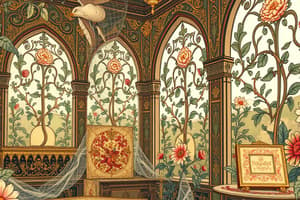Podcast
Questions and Answers
Harmony in design produces an impression of unity through the selection and arrangement of _______ objects or ideas.
Harmony in design produces an impression of unity through the selection and arrangement of _______ objects or ideas.
True (A)
Repetition implies the use of three or more different elements such as colors, shapes, or lines.
Repetition implies the use of three or more different elements such as colors, shapes, or lines.
False (B)
The harmony of size refers to a balanced and harmonious arrangement of different sized elements, such as a set of Russian nesting dolls.
The harmony of size refers to a balanced and harmonious arrangement of different sized elements, such as a set of Russian nesting dolls.
True (A)
Contrasting harmonies are achieved by using similar colors located near each other on the color wheel.
Contrasting harmonies are achieved by using similar colors located near each other on the color wheel.
Transitional lines are harsh, sharp lines characterized by abrupt changes and angles.
Transitional lines are harsh, sharp lines characterized by abrupt changes and angles.
Flashcards are hidden until you start studying
Study Notes
Design Principles
- Design involves arranging art elements to create beauty and unique perceptions of objects.
- Good design emerges from the careful application of design principles, integrating elements of art into a cohesive whole.
- Understanding design principles is beneficial as everyone engages in design in various forms.
Harmony
- Harmony creates a sense of unity through consistent object or idea arrangement.
- Five aspects of harmony include:
- Harmony of lines and shapes: Balanced arrangement of lines and shapes enhances visual appeal.
- Harmony of size: Ensures visual proportion; e.g., Russian nesting dolls demonstrate size harmony through proportional gradation.
- Harmony of color: Involves using multiple colors without mixing; includes related harmonies (similar shades) and contrasting harmonies (opposite colors).
- Harmony of texture: Best practices suggest avoiding combinations of coarse and fine textures; texture can be assessed by touch or sight.
- Harmony of ideas: Relates to the compilation of common concepts to ensure coherent presentation.
Rhythm
- Rhythm in design refers to uniform visual movement achieved through unit or motif repetition.
- It is essential in performing arts, provokes immediate emotional responses, and is prevalent across various art forms.
- Types of rhythm include:
- Formal or uniform rhythm: Repetition of a motif in a consistent arrangement.
- Informal or free rhythm: Variations in motif form, size, and arrangement while maintaining repetition.
Balance
- Balance promotes feelings of rest, equilibrium, and stability in design.
- Mathematically balanced objects have equal weights and are positioned equally from a central axis.
- Visual weight attracts attention to elements in art and design. Balance can occur:
- Horizontally, vertically, or diagonally: Proper distribution ensures visual harmony.
- Balance types include:
- Formal or symmetrical balance: Objects are nearly identical, creating clear visual harmony; e.g., the Taj Mahal exemplifies this balance through its symmetrical architecture.
- Informal or asymmetrical balance: Relies on differing objects arranged to create a dynamic yet balanced composition.
Studying That Suits You
Use AI to generate personalized quizzes and flashcards to suit your learning preferences.




